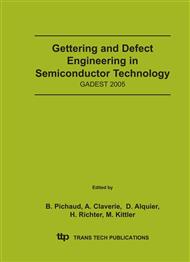p.591
p.597
p.603
p.609
p.615
p.621
p.627
p.631
p.637
Atomic Environment of Positrons Annihilating in HT Cz-Si Crystal
Abstract:
A probing of the atomic environment of positron in Cz-Si single crystal heat-treated at T=600C and T=450C has been performed by one-dimensional angular correlation of annihilation radiation (ACAR). It has been established that positrons get trapped by the oxygen-related complexes. The penetration of positrons into the core region of surrounding atoms results in emission of the elementally specific high-momentum annihilation radiation. The processes of expelling of positron from ion cores and its penetration into the core region are regulated by the potential barrier (to be considered as the Coulomb’s one as a first approximation). The characteristic electron-positron ion radius and the probabilities of correlated events of the highmomentum annihilation are due to the chemical nature of the ion cores of atoms involved in the composition of the oxygen-related complexes. The interpretation of the results is based on the notion of the positron localization in the field of negative effective charge resulted from comparatively high electron affinity of the oxygen impurity atom. The presence of a free volume (perhaps, a vacancy) as well as the carbon atom in the microstructure of the oxygen-related positron-sensitive thermal defects is briefly discussed.
Info:
Periodical:
Pages:
615-620
Citation:
Online since:
December 2005
Authors:
Price:
Сopyright:
© 2005 Trans Tech Publications Ltd. All Rights Reserved
Share:
Citation:


